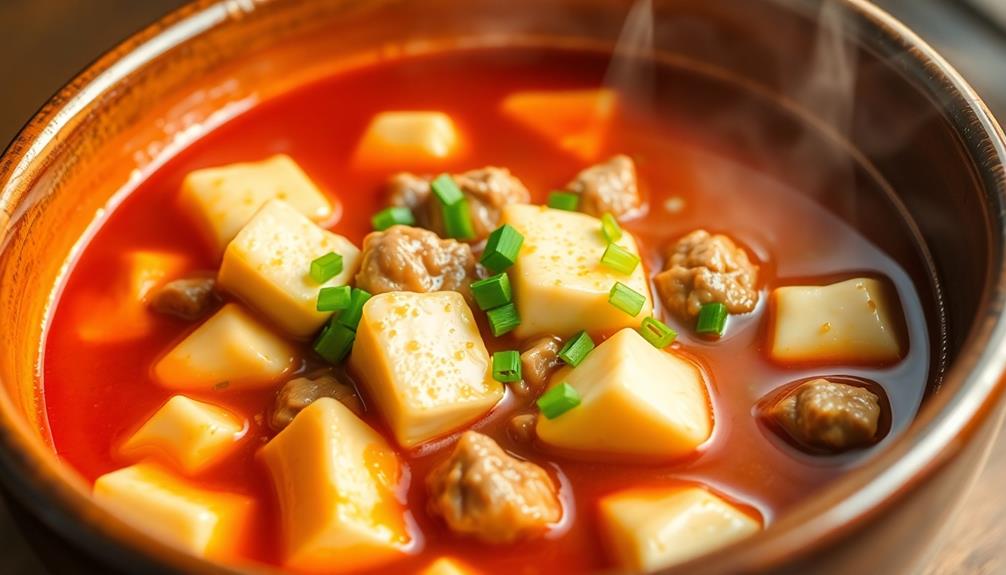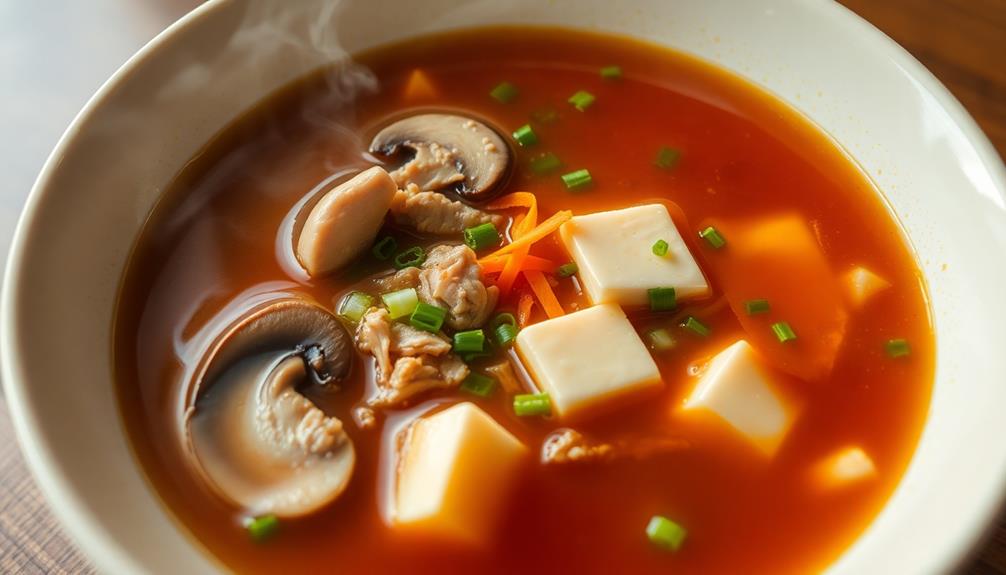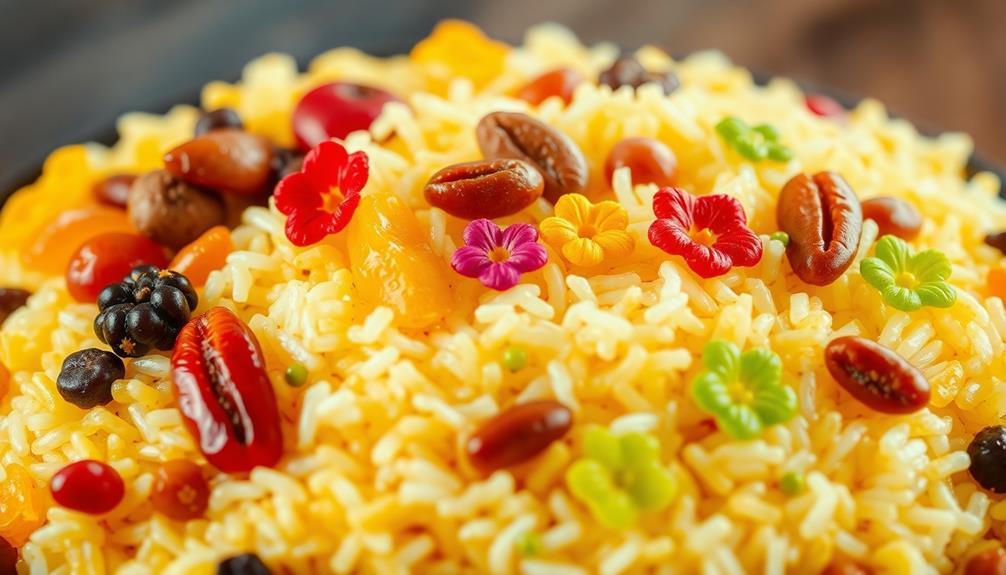Mapo tofu is a beloved Chinese dish from the Sichuan province that'll tantalize your taste buds! It combines the bold, numbing flavors of fermented chili bean paste and Sichuan peppercorns with silky soft tofu, creating a comforting yet adventurous fusion. The secret lies in balancing the savory, spicy, and umami notes to perfection. You'll start by sautéing ground pork, then gently incorporating the tofu and signature sauce. The result is a dish that's loaded with complex flavors and a delightful texture. Intrigued? Keep reading to uncover the full recipe and cooking tips!
Key Takeaways
- Mapo Tofu is a classic Sichuan dish that originated in the 19th century, known for its bold, spicy, and complex flavor profile.
- The dish combines soft tofu, ground pork, and a savory sauce made with fermented bean paste, Sichuan peppercorns, and other aromatic ingredients.
- Mapo Tofu is considered a beloved comfort food in China and has gained global popularity, showcasing the versatility of Chinese cuisine.
- Key to the success of Mapo Tofu lies in the balance of ingredients and the preparation of the sauce, which should achieve a glossy sheen.
- The dish is protein-rich and can be modified to suit various dietary preferences, offering a lower-calorie alternative compared to meat-centric dishes.
History
Mapo tofu's origins can be traced back to the Sichuan province of China in the 19th century. The dish's name comes from the Sichuan word "má", which means "numb", and "pó", which means "old woman". This refers to the distinct spicy and numbing sensation that the dish provides.
The original recipe was created by a clever woman who owned a small restaurant in Chengdu, the capital of Sichuan. She combined soft tofu, ground beef, and a signature blend of Sichuan peppercorns and chili peppers to make a deliciously hot and flavorful meal.
Over time, mapo tofu became a beloved classic of Sichuan cuisine, known for its bold, complex taste. Today, it's enjoyed all over China and the world, with variations that incorporate different proteins and ingredients.
But no matter how it's prepared, the heart of mapo tofu remains the same – a spicy, savory, and utterly satisfying dish that's sure to delight your taste buds.
Recipe
Mapo Tofu is a classic Sichuan dish that combines the bold flavors of fermented bean paste, Sichuan peppercorns, and silky tofu. This spicy and numbing dish is a beloved comfort food in China and has gained popularity worldwide. The key to a delicious Mapo Tofu lies in the right balance of ingredients and the careful preparation of the sauce.
To begin, the dish starts with a flavorful base of minced or ground pork, which is then simmered with fermented bean paste, Sichuan peppercorns, and other aromatic ingredients to create a complex and addictive sauce. The sauce is then poured over soft and tender tofu cubes, creating a harmonious blend of textures and flavors.
Ingredients:
- 1 block of firm or extra-firm tofu, cut into 1-inch cubes
- 1/2 pound ground pork or beef
- 2 tablespoons fermented chili bean paste (doubanjiang)
- 1 tablespoon Sichuan peppercorns, lightly crushed
- 3 cloves of garlic, minced
- 1 tablespoon grated ginger
- 2 tablespoons soy sauce
- 1 tablespoon Shaoxing wine or dry sherry
- 1 tablespoon cornstarch
- 2 cups chicken or vegetable broth
- 2 tablespoons vegetable oil
- 2 scallions, sliced
- Sesame oil, for drizzling
Instructions:
In a wok or large skillet, heat the vegetable oil over medium-high heat. Add the ground pork and cook, breaking it up with a wooden spoon, until browned and cooked through, about 5-7 minutes. Drain any excess fat from the pan.
Add the fermented chili bean paste, Sichuan peppercorns, garlic, and ginger, and cook for an additional 2-3 minutes, stirring constantly, to release the flavors. Pour in the soy sauce, Shaoxing wine, and broth, and bring the mixture to a simmer.
Gently add the tofu cubes and cook for 5-7 minutes, spooning the sauce over the tofu to coat it. In a small bowl, mix the cornstarch with a tablespoon of water to create a slurry. Slowly pour the slurry into the wok, stirring constantly, until the sauce thickens to your desired consistency.
Remove from heat and garnish with the sliced scallions. Drizzle with a touch of sesame oil before serving.
Tips:
- Use high-quality fermented chili bean paste for the best flavor.
- Lightly crushing the Sichuan peppercorns helps release their fragrant and numbing properties.
- Opt for firm or extra-firm tofu to prevent it from falling apart during cooking.
- Adjust the spice level to your preference by adding more or less fermented chili bean paste.
- Serve Mapo Tofu with steamed rice for a complete and satisfying meal.
Cooking Steps
To start, you'll sauté some pork in hot oil until it's nice and crispy.
Next, you'll add the tofu and give it a good stir to coat everything evenly.
Then, you'll stir in that tasty doubanjiang paste, along with some chili peppers for a little kick.
Step 1. Sauté Pork in Hot Oil
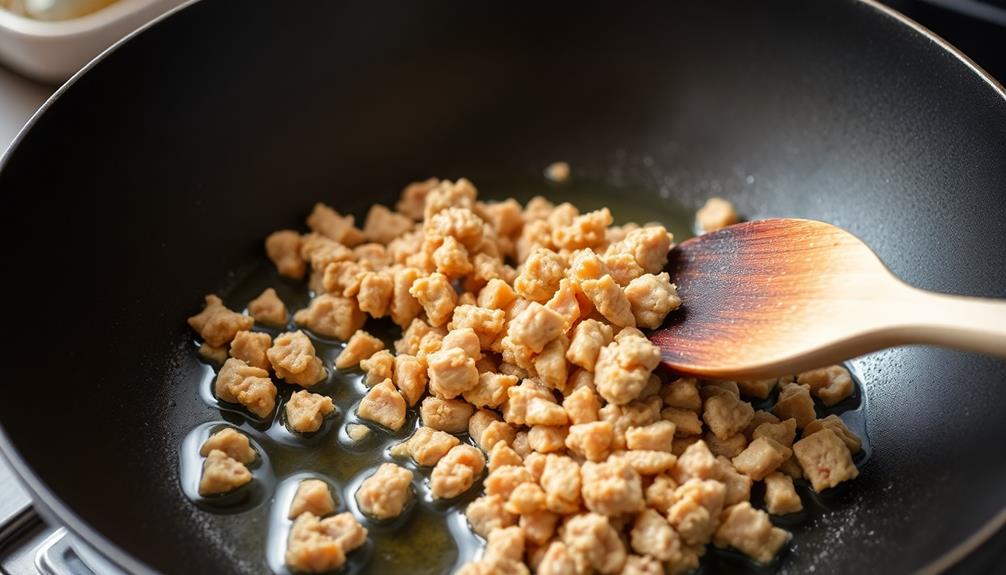
Begin by heating a generous amount of oil in a wok or large skillet over high heat.
Once the oil is shimmering, it's time to add the pork. Sauté the pork, breaking it up with a spatula as it cooks, until it's browned and crispy, about 5-7 minutes.
Don't be afraid to let the pork get a nice sear – you want those tasty little bits to develop!
Now, it's time to crank up the heat even more.
Carefully add the fermented black beans, Sichuan peppercorns, and chili bean sauce to the hot oil.
Stir-fry everything together for about a minute, until the aromas start to fill the air.
This quick sauté helps to bring out the flavors and infuse the oil.
Step 2. Add Tofu and Stir
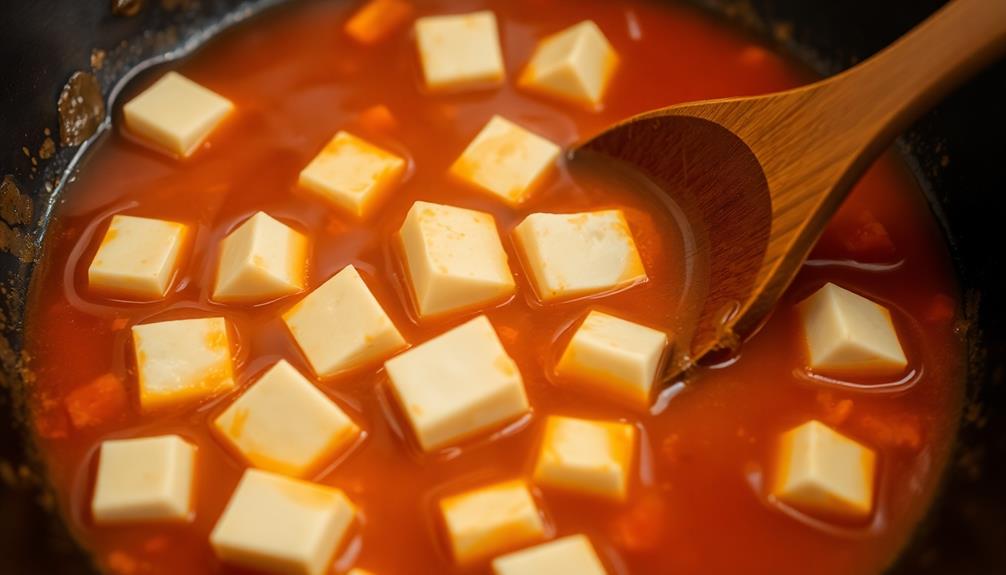
With the aromatics sizzling in the wok, it's time to add the star of the dish – the tofu.
Grab those silky tofu cubes and gently lower them into the hot oil. They'll sizzle and dance, absorbing all the savory flavors around them.
Stir the tofu carefully, making sure each piece gets coated in the aromatic sauce. Don't be afraid to let it brown a bit on the edges – that's where the magic happens! Now, it’s time to add in the rest of the ingredients for our delicious tomato egg stirfry recipe. Toss in the diced tomatoes, green onions, and beaten eggs, and gently fold everything together. Let the mixture simmer until the eggs are just set and the tomatoes have released their juices, creating a flavorful sauce. Once everything is well combined, serve the tofu and tomato egg stirfry over a bed of steamed rice for a satisfying and savory meal.
The tofu will soak up the spices and transform into a heavenly, tender treat. Keep stirring and tossing until the tofu is heated through, about 2-3 minutes.
You'll know it's ready when it's slightly crispy on the outside but still soft and creamy on the inside.
Now that the tofu's joined the party, get ready for an explosion of flavor in every bite.
The stage is set for the final act – the finishing touches that will make this Mapo Tofu dish absolutely unforgettable.
Step 3. Add Doubanjiang Paste
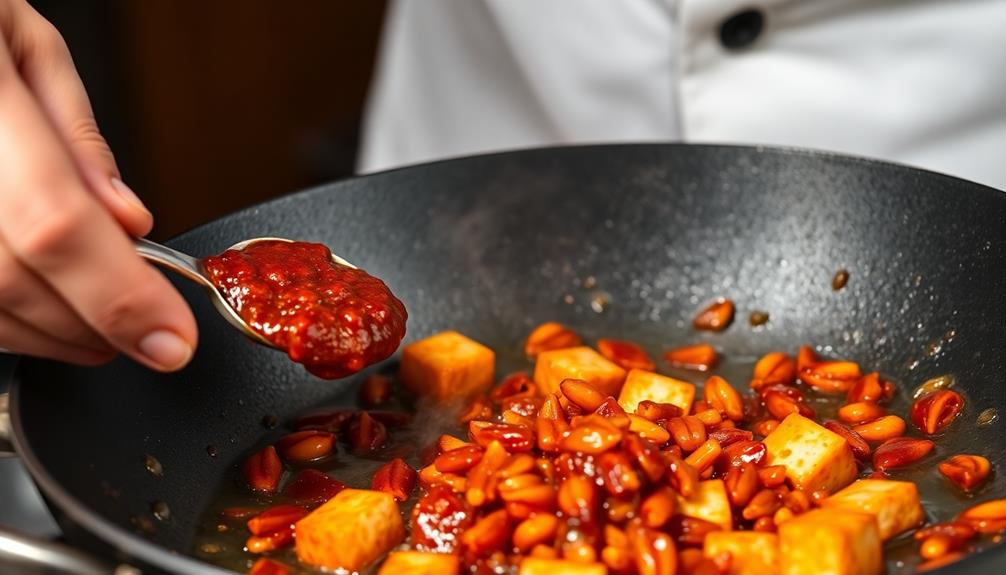
The Doubanjiang paste is the heart and soul of this Mapo Tofu dish. It's a savory, pungent sauce made from fermented broad beans, chili peppers, and spices. You'll want to add a generous amount – about 2 tablespoons – to your pan. As the Doubanjiang paste sizzles in the pan, its rich aroma infuses the entire dish, adding incredible depth of flavor. Be sure to sauté it well to release all the umami goodness before adding other ingredients like garlic and ginger. While this spicy tofu dish brings the heat, you can always balance the meal with a sweet, creamy panna cotta dessert recipe for a perfect finish.
Stir it in with the garlic and ginger, letting the flavors meld and the paste sizzle. The Doubanjiang will instantly transform your dish, infusing it with a bold, umami-rich taste. As it cooks, the paste will caramelize and thicken, coating the tofu and pork in a fiery red sauce.
Don't be shy with it – the more you use, the more intense the Mapo Tofu will be. Just be ready for a tongue-tingling experience!
Stir the Doubanjiang continuously to prevent burning, and let it simmer for a minute or two until it becomes fragrant and deeply colored. This is the crucial step that sets Mapo Tofu apart, so don't skimp on the paste.
Get ready for your taste buds to be blown away!
Step 4. Add Chili Peppers
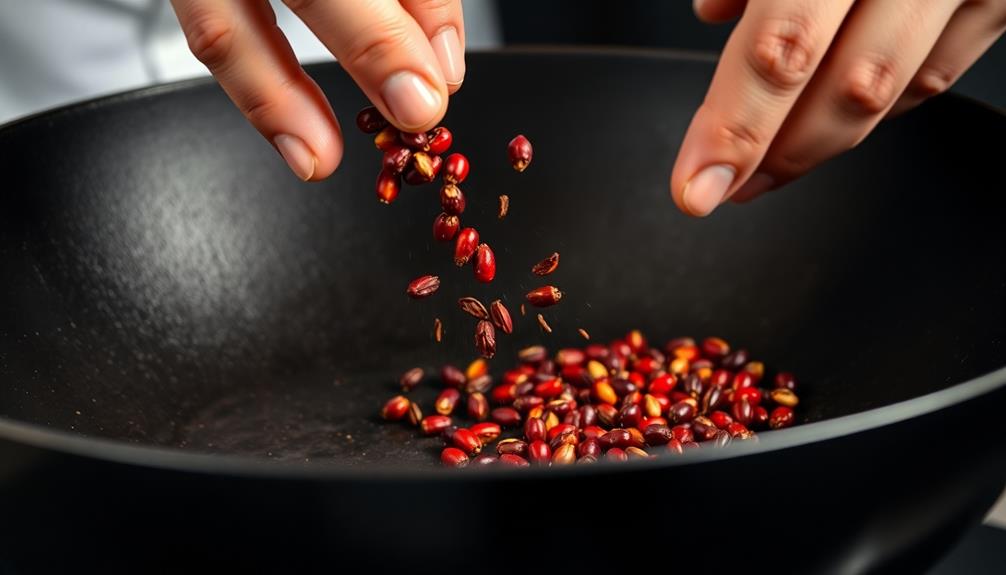
Next, add the chili peppers. These spicy little veggies will give your Mapo Tofu a real kick of flavor! Grab a handful of dried chili peppers and carefully slice them into thin strips. You can use a sharp knife or kitchen scissors for this.
Toss the pepper strips right into the sizzling pan along with the doubanjiang paste. The peppers will sizzle and release their fragrant aroma, filling your kitchen with the mouth-watering scent of Sichuan cuisine.
As the peppers cook, they'll start to turn a deeper red color. Keep stirring everything together so the flavors meld perfectly.
Feel free to add a few more pepper strips if you like things extra spicy. Just be careful – a little goes a long way! The chili peppers will add the final kick of heat to your Mapo Tofu, making it irresistibly delicious.
Get ready for an explosion of flavor in every bite!
Step 5. Add Stock and Simmer
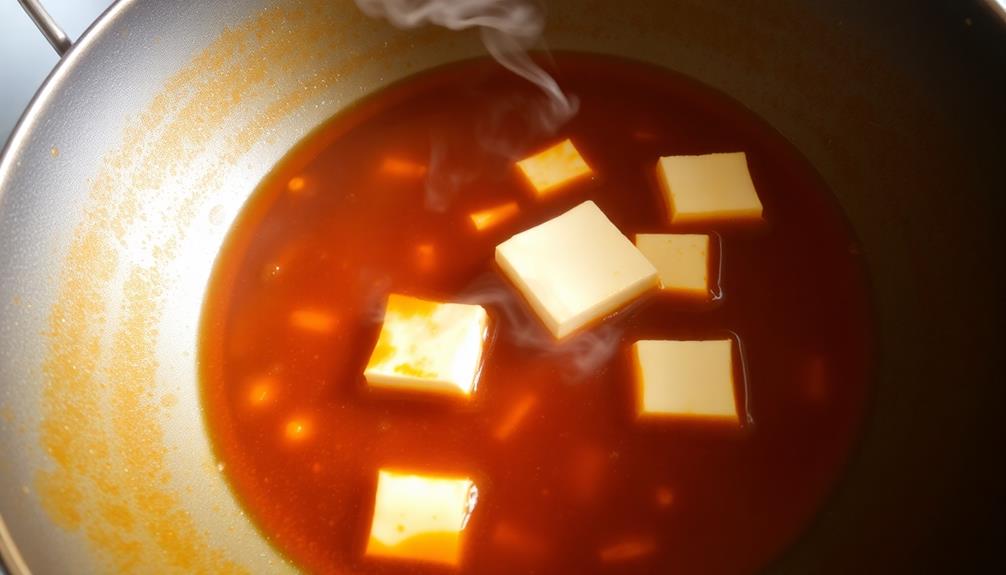
After sizzling the chili peppers, pour in the stock. This salty, savory liquid will help create a rich, aromatic sauce for your Mapo Tofu. Gently pour in the stock, making sure to scrape up any browned bits stuck to the bottom of the pan. These tasty morsels will add even more flavor to the dish.
Now, let the mixture simmer for about 5 minutes. This allows the stock to reduce and thicken, creating a silky, velvety texture. During this time, the tofu will also soak up all those yummy flavors. Keep an eye on it, stirring occasionally, to ensure nothing sticks or burns.
The sauce should now have a nice, glossy sheen. Mmm, can you just imagine how delicious it's going to taste? Before moving on, give it a quick taste and adjust the seasoning if needed. You want that perfect balance of savory, spicy, and a hint of sweetness.
Now, it's time to add the tofu and finish up this scrumptious Mapo Tofu!
Final Thoughts
With Mapo Tofu, you've now explored the rich flavors and cultural significance of this iconic Sichuan dish.
You've learned how to prepare the tofu, create the signature sauce, and balance the spicy, savory, and numbing sensations. It's a dish that's both comforting and thrilling, perfect for sharing with family and friends.
Mastering Mapo Tofu takes some practice, but the end result is so worth it. The depth of flavor and textural contrast make every bite an absolute delight.
Plus, you can feel good knowing you've prepared a healthful meal that's packed with protein and nutrients.
Going forward, don't be afraid to experiment with the recipe. Try adding different types of mushrooms, switching up the chili peppers, or even incorporating ground meat for a heartier version.
The possibilities are endless! With Mapo Tofu in your culinary arsenal, you're ready to impress your loved ones and explore the wonders of Sichuan cuisine.
Frequently Asked Questions
Is Mapo Tofu Spicy?
Yes, mapo tofu is generally quite spicy. The dish features a bold, flavorful sauce made with chili peppers, Sichuan peppercorns, and other seasonings that give it a fiery kick. If you don't enjoy spicy foods, you may want to try a milder version.
What Is the Origin of Mapo Tofu?
Mapo tofu originated in the Sichuan province of China. It's a classic Sichuan dish that features a savory and spicy sauce made with fermented bean paste, chili oil, and Sichuan peppercorns. This flavorful dish has become popular worldwide.
How Long Does Mapo Tofu Take to Cook?
Typically, it takes around 20 to 30 minutes to cook mapo tofu. The actual cooking time can vary depending on the recipe and the size of the tofu cubes. You'll want to simmer the dish until the flavors have melded together nicely.
Can I Make Mapo Tofu Vegetarian?
Absolutely! You can easily make a vegetarian version of this classic dish. Simply substitute the ground meat with your preferred plant-based protein, and adjust the seasonings to suit your tastes. It's a delicious and versatile option.
What Protein Is Best for Mapo Tofu?
You've got options when it comes to the protein for your dish. Firm or extra-firm tofu is a classic choice, but you could also use vegetarian ground beef or mushrooms for a meat-free take. The key is finding a protein that complements the bold flavors.
